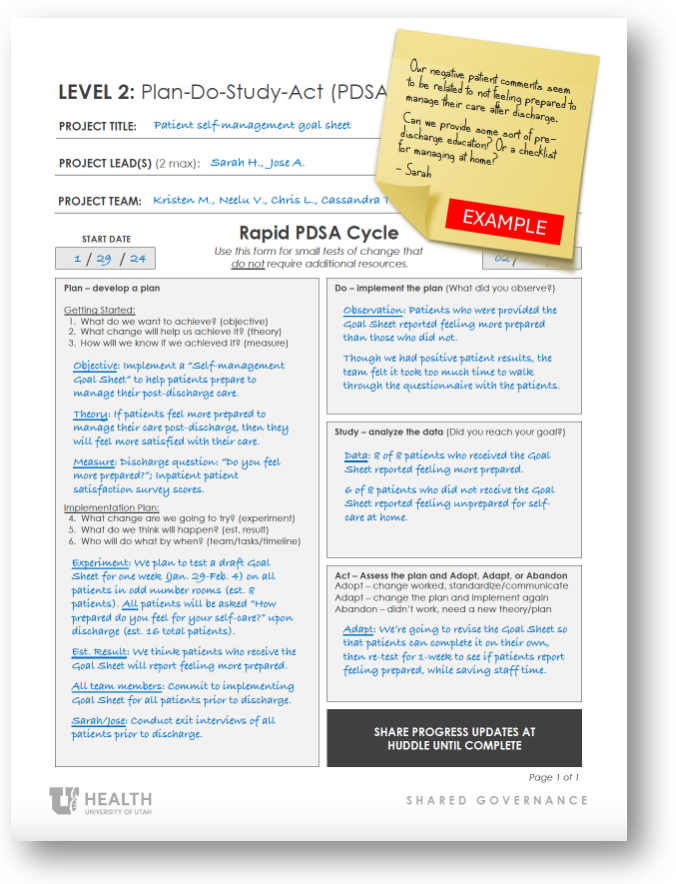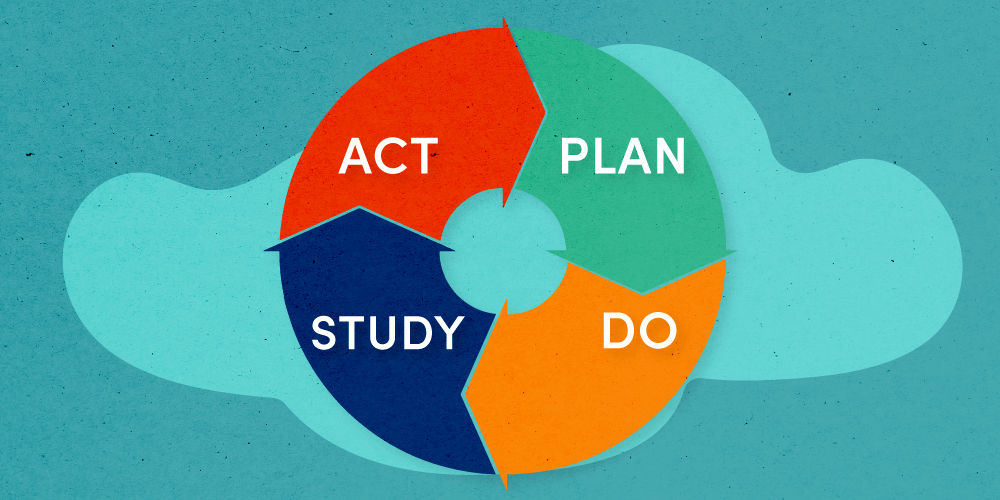PDSA Templates

For smaller projects that do not require resources, download the Rapid PDSA Template here.
For larger projects that require resources, download the full PDSA Cycle Template here.
lan-Do-Study-Act (PDSA) is a simple way to test a change that has been implemented. This simple four step cycle starts with developing a plan by identifying the small steps (or tasks) required to make a change, implementing the change, analyzing the data, and adjusting the plan before going forward.
When do I use it? In Shared Governance, we use PDSA cycles to resolve Level 2: Problems, Ideas, Needs and Suggestions (PINS). It works great if you need to improve an existing process, test a new process, or to solve problems using known methods (e.g., protocols, standard work).
How do I get started? Download one of these PDSA templates and follow the step-by-step guidance provided below.
- Rapid PDSA Template - for smaller projects (no additional resources required)
- PDSA Cycle Template - for larger projects (resources required)
PLAN - identify an opportunity and plan for improvement
Project Lead(s) clarify the aim, desired impact, and resource needs:
- Aim statement – Why are we addressing this Problem/Idea/Need/Suggestion?
- Desired impact – How will addressing it positively impact or benefit the team, our patients, or the organization?
- Resource needs – What resources (time, budget, supplies, etc.) do we think we will need to be successful?
 Shared Governance: Check-in with your mentor before getting started. They can help answer questions and lobby for resources you might need.
Shared Governance: Check-in with your mentor before getting started. They can help answer questions and lobby for resources you might need.
During team huddle or a separate meeting, the Project Team works together to outline:
- Objective – What do we want to achieve?
- Key result(s) – What changes can we make that will help us achieve it?
- Measure(s) – How will we know if we achieved it? (Is there a unit of measurement for comparison? Think before and after—how will you measure change?)
- SMART Goal – write a first draft of a Specific, Measurable, Attainable, Relevant and Time-bound goal. (e.g., We plan to improve [what] by [doing what] [measured how] from [baseline/starting point] to [goal] by [MM/DD/YY].)
 Shared Governance: Share what the team develops at next Team Board huddle. Seek feedback from the expanded team and make updates as needed.
Shared Governance: Share what the team develops at next Team Board huddle. Seek feedback from the expanded team and make updates as needed.
Identify your baseline, which is a summary of the current state or approach:
- Obtain existing baseline data, or create and execute a data collection plan
- Obtain input from stakeholders (What do people impacted by the change think about the data?)
- Analyze and display baseline data on the Task List
- Determine root cause(s) or problem(s)
- Revise objective and SMART goal (if needed)
Once you know your baseline, identify a potential solution:
- Identify all potential solutions based on the root cause(s)
- Review evidence and/or local best practices to identify potential improvements
- Identified solution: Pick the best solution (the one most likely to accomplish your objective)
- Improvement theory – develop a theory for improvement (a prediction using “if…then” approach)
- Develop a strategy to test the theory
 Shared Governance: Share baseline, identified solution and theory at next huddle. Get fedback from the team and adjust plan as needed.
Shared Governance: Share baseline, identified solution and theory at next huddle. Get fedback from the team and adjust plan as needed.
DO - Implement your plan and test your theory
- Implement your plan on a small scale (test it)
- Document observations, including any problems and unexpected findings
- Outcome – collect data you identified as needed during “plan” stage
STUDY - Analyze the data
Summarize your findings – was the test successful?
- Compare results against baseline data and measures of success
- Did results match the theory/prediction?
- Were there unintended side effects?
- Was there an improvement?
- Do you need to test the improvement under other conditions?
Data tells you? Describe what you learned based on implementing the change.
ACT - Act on the learnings
Assess the results of the “Do” and “Study” phases to determine whether to:
- Adopt: standardize the change
- Adapt: adjust the change process for improved results
- Abandon: drop unsuccessful theories and start again with a new theory
Take steps to preserve gains and sustain accomplishments (if any)
Next steps: Make long-term plans for additional improvements (if needed)
Conduct iterative PDSA cycles (when needed)
Shared Governance: Share what you learned during the next Team Huddle and close out the PINS.
- Celebrate your success – every completed PIN is a big team win!
- Communicate what you did/learned at a Council meeting (Mentor/Excellence).
- For significant results, consider sharing your project externally.
References:
- Boston University SHIELD. PDSA Cycle Checklist Job Aid (2020).
- Institute for Healthcare Improvement. QI Essentials Tookit: PDSA Worksheet (2017).
Mary-Jean (Gigi) Austria
Kripa Kuncheria
Kim Mahoney
The team has worked hard to post problems, ideas, needs, and suggestions on the Team Board. Now what? Magnet program director Gigi Austria and colleagues share a host of resources to guide you from Post-It Note to completion.
While it’s true that large scale changes are required to make a significant difference in how things work, consistent small improvements add up to big impact over time. Magnet program director Gigi Austria and project management experts Kripa Kuncheria and Kim Mahoney explain when and how to Just-Do-It.
Magnet Program Director Mary-Jean (Gigi) Austria explains how Nursing Shared Governance provides support for knowledge sharing, clinical skill building, and collaborative decision-making closest to the point of care.
